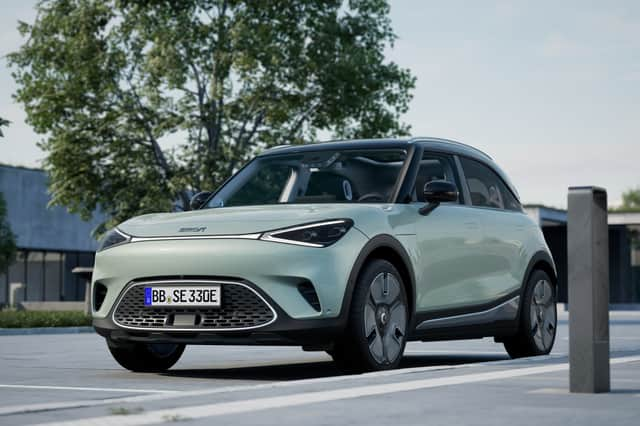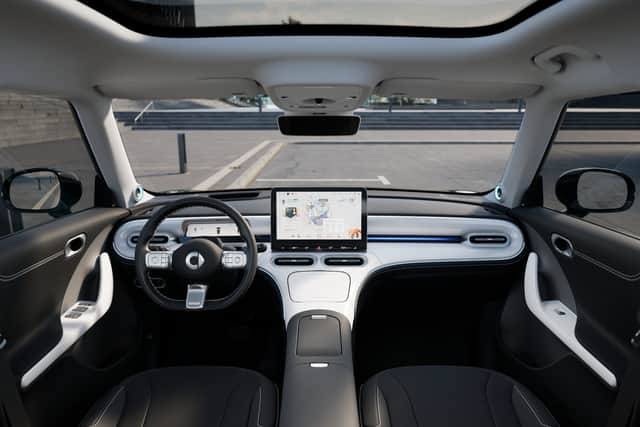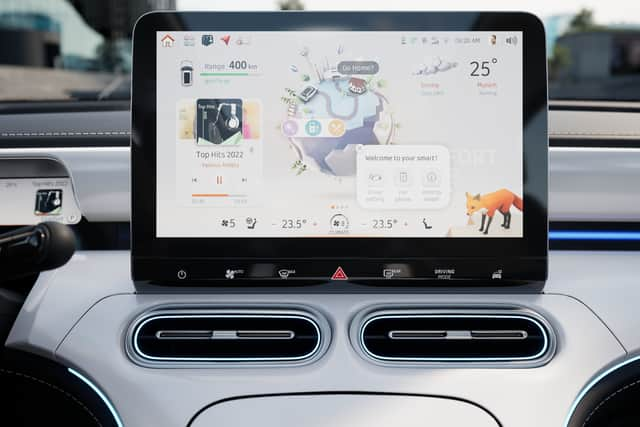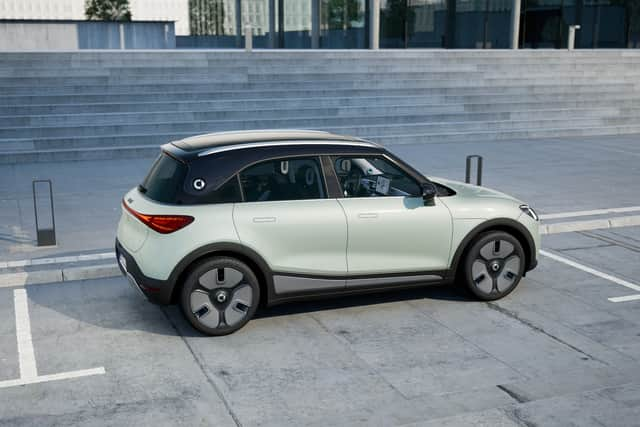Smart #1 review: small brand goes big with premium electric SUV


Remember the Smart car? Of course you do. It was the tiny, two-door, two-seat machine that arrived in the late 1990s to revolutionise how we got around the city.
Capable of being parked nose-in to the kerb in a regular space and with virtually no extraneous bodywork beyond its rigid central safety cell, it was like a scaled up Little Tykes Cozy Coupe and even 25 years later there’s virtually nothing like it on the road.
Advertisement
Hide AdAdvertisement
Hide AdThe closest we’ve got now is probably the limited Citroen Ami EV but, even then, Smart beat Citroen to the punch by equipping the Smart Coupe with an electric drivetrain back in 2019.
That was a fairly short-range, low-power affair, however, and in a world of changing tastes and regulations, never destined to be a big seller. So Smart has reinvented itself to stay relevant in a world obsessed with SUVs and long EV ranges, bringing us the #1 (yes, you’re supposed to say Hashtag One).
Forget any notions of Smart cars being teeny-tiny runarounds, the #1 is a proper “compact” SUV with four doors, space for four people and road presence that’ll get you noticed, plus the option of a frankly ridiculous performance variant.
At 4.27m long, 1.6m high and 1.8m wide, the #1 around the same size as a Mini Countryman. However, its design somehow makes it look even bigger. The bonnet is low, long and broad, with huge wide-set headlights, which makes the roofline look even higher and gives a slightly awkward head-on view. Other angles are more forgiving thanks to a fluid design that uses a few simple lines to sketch out the soft-edged shape with its neat “floating” roof effect. Buyers can choose from four single-colour exterior finishes or eight two-tone designs that paint the roof a different shade.
Advertisement
Hide AdAdvertisement
Hide AdThe interior follows a similar flowing design and works really well to give a modern, premium feel to the car. The dashboard is one large flowing panel of glossy white plastic (think early iPod) that wraps letterbox-style around the instruments and flows seamlessly into the high-set centre console. Front seat passengers will feel cocooned but not constrained by that centre console, which features neatly hidden high-level cupholders, phone charger and USB ports, while a huge open storage space underneath offers space for even the biggest handbag while creating an airy feel.
The airy feel is enhanced by the high roofline, large windows and a massive panoramic sunroof that’s standard across the range.


Smart says that the #1 offers similar cabin space to a Mercedes E-Class despite being 58cm shorter. That’s partly thanks to the long wheelbase offered by the EV platform and partly thanks to the upright SUV seating position. What it means is that there’s impressive space for four adults inside, with generous knee and headroom for a car in this class. Larger drivers beware, however - the seats are fairly narrow. There’s also up to 411 litres of boot space - although you’ll have to slide the rear bench forward and rob passengers of legroom to achieve that.
Like every modern car, the #1’s dashboard is dominated by a touchscreen - 12.8 inches in this case. It’s a sharp and responsive system with an interface like nothing you’ve seen before, featuring a cartoony planet background and a giant fox (the avatar for the car’s voice-controlled assistant) cavorting around on-screen. Despite the thoroughly unusual appearance, the system is well thought out, with quick access and clear menu options for most important functions.
Advertisement
Hide AdAdvertisement
Hide AdHigher-spec versions of the car also benefit from a head-up display, which is handy because the digital instrument panel is tiny and set so low in the dash that it’s hard to see at a glance.
Under the skin, the Smart #1’s platform is from Chinese auto giant Geely and next year we’ll see the same underpinnings used in the Volvo EX30, which is set to become one of the #1’s most important rivals.


Most versions of the #1 come with a simple single-motor powertrain. That 268bhp motor drives the rear wheels and delivers impressively punchy performance for what is, essentially, a city-focused runaround. Zero to 62mph takes 6.7 seconds and even in comfort driving mode there’s a sharp throttle response that makes it easy to dart around the city centre or perform higher-speed overtakes.
However, you’re likely to limit your high-speed antics on the open road due to a driving experience that doesn’t inspire confidence. The #1 has a strangely high driving position, even for an SUV, which means those on board are very aware of the top-heavy feel of the car. There’s a surprising amount of lean and body roll that comes with manoeuvres at more than urban speeds - at odds with the usually planted feel of EVs with their low-slung batteries.
Advertisement
Hide AdAdvertisement
Hide AdPart of the roll is undoubtedly down to the soft setup of the suspension, which is clearly designed to offer a smooth ride around town. But even that is only a partial success. It deals well with large problems like potholes and drain covers, removing the harsh impacts before they reach the cabin, but there’s an underlying jitteriness to the ride that means it never feels properly resolved or settled.
Every version of the #1 comes with a 62kWh battery and rapid 150kW charging. Entry level Pro+ models should cover 260 miles on a charge while Premium versions get a heat pump and high-tech inverter that help stretch the official range to 273 miles. Brabus models, however, drop this to 248 miles.


That’s because the Brabus version of the #1 gets a second, front-mounted, motor that takes power up to 422bhp and brings the 0-62mph time down to a ridiculous 3.9 seconds.
The Brabus gets revised front suspension to cope with the weight of the extra motor and an additional drive mode but is otherwise mechanically the same, meaning the same brakes, tyres and suspension tuning as the regular models. The rest of the Brabus spec is about sporty aesthetics, with unique 19-inch wheels, a more muscular body kit, larger spoiler and some interior nods to the famous tuning house name.
Advertisement
Hide AdAdvertisement
Hide AdThat’ll set you back £43,450 but the #1 Pro+ starts at £35,950, where its more premium pretensions come up against the spacious and well-equipped likes of the Kia Niro EV, Hyundai Kona Electric, Renault Megane e-Tech, BYD Atto 3 as well as the sporty Cupra Born hatchback.
Every #1 comes with a panoramic sunroof, LED lights, heated seats, powered tailgate, adaptive cruise control and a 360-degree surround camera, meaning it’s well kitted out for the price. Premium spec costs an extra £3k and brings matrix adaptive headlights, head-up display, Beats 13-speaker sound system and automatic parking assistant.
The #1 is certainly a new direction for Smart and there’s plenty to like about it, from the slick, stylish interior to the impressive pace and range of the electric drivetrain. That and the generous levels of high-tech equipment on offer will be enough to convince many buyers but poor road manners, including an unsettled ride and slack body control mean I’m not 100% sold on the #1.
Smart #1 Premium
- Price: £38,950
- Motor: Single-rear mounted 200kW
- Battery: 62kWh
- Power: 268bhp
- Torque: 252lb ft
- Transmission: Single-speed, rear-wheel drive
- Top speed: 112mph
- 0-62mph: 6.7 seconds
- Range: 273 miles
- Consumption: 3.7m/kWh
- Charging: up to 150kW
Rivals: Kia Niro EV, Hyundai Kona Electric, BYD Atto 3
Comment Guidelines
National World encourages reader discussion on our stories. User feedback, insights and back-and-forth exchanges add a rich layer of context to reporting. Please review our Community Guidelines before commenting.
